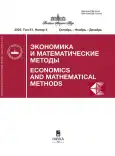Using online data to construct hedonic price indices for smartphones
- Autores: Latypov R.R.1,2, Postolit E.A.3, Akhmedova E.A.3
-
Afiliações:
- VTB
- Moscow State University
- Euler Research Technologies
- Edição: Volume 61, Nº 4 (2025)
- Páginas: 58-72
- Seção: Industrial problems
- URL: https://stomuniver.ru/0424-7388/article/view/697029
- DOI: https://doi.org/10.31857/S0424738825040052
- ID: 697029
Citar
Texto integral
Resumo
In this work, hedonic indices and hedonic regressions are estimated for smartphone prices. The indices are built using a special collection of big data from online retailers that comprises a large number of representative observations and a wide range of product attributes (1.9 million distinct smartphone price observations since July 2022). We demonstrate that, for smartphones, the dynamics of hedonic indices built with the techniques suggested in the literature are substantially greater than Rosstat price index. Furthermore, we indirectly validate that the skimming pricing strategy of smartphones, in which a high price is initially set for a variety and then lowered. In the case of using simple methods of accounting for quality in the consumer price index, that is common among statistical agencies, the use of pricing strategies by manufacturers and retailers, along with frequent changes in product ranges, ultimately result in the depletion of the observation sample and a bias in the consumer price index. This supports the use of hedonic regression-based techniques to enhance the ways in which price dynamics are adjusted for changes in quality. Hedonic regressions should use all quality attributes that are pertinent to price fluctuations as regressors rather than fixed effects of varieties, according to another finding. A bias in the consumer price index happens when simplified regression specifications are used. For price adjustments, Rosstat will be encouraged to collect information on all qualitative traits of the varieties. Increased confidence in the published data will result from the addition of hedonic methods to Rosstat’s toolkit, which will help make the published CPI more representative.
Palavras-chave
Sobre autores
R. Latypov
VTB; Moscow State University
Email: Rodion.Latypov@vtbcapital.ru
Moscow, Russia
E. Postolit
Euler Research Technologies
Email: Egor.Postolit@euler.team
Moscow, Russia
E. Akhmedova
Euler Research Technologies
Email: Elena.Akhmedova@euler.team
Moscow, Russia
Bibliografia
- Житков К. В., Ратникова Т. А. (2014). Построение гедонистических ценовых индексов на полотна художников-фовистов // Прикладная эконометрика. № 3 (35). С. 59–85. [Zhitkov K. V., Ratnikova T. A. (2014). Construction of hedonic price indices for paintings by Fauvist artists. Applied Econometrics, 3 (35), 59–85 (in Russian).]
- Зямалов В. Е., Турунцева М. Ю. (2024). Анализ влияния качественных свойств товаров на их ценовые индексы // Журнал Новой экономической ассоциации. № 1 (62). С. 196–209. doi: 10.31737/22212264_2024_1_196-209 [Zyamalov V. E., Turuntseva M.Yu. (2024). Analysis of the influence of qualitative properties of goods on their price indices. Journal of the New Economic Association, 1 (62), 196–209. doi: 10.31737/22212264_2024_1_196-209 (in Russian).]
- Игнатенко А., Михайлова Т. (2015). Ценообразование на рынке аренды офисной недвижимости Москвы: гедонический анализ // Экономическая политика. Т. 10. № 4. 156–177. [Ignatenko A., Mikhailova T. (2015). Pricing in the Moscow office rental market: Hedonic analysis. Economic Policy, 10, 4. 156–177 (in Russian).]
- Исаков А., Латыпов Р., Репин А., Постолит Е., Евсеев А., Синельникова-Мурылева Е. (2021). Твердые цифры: открытые микроданные о потребительских ценах // Деньги и кредит. Т. 80. № 1. Март. С. 104–119. [Isakov A., Latypov R., Repin A., Postolit E., Evseev A., Sinelnikova-Muryleva E. (2021). Hard numbers: Open consumer price database. Russian Journal of Money and Finance, 80 (1), 104–119 (in Russian).]
- Турунцева М. Ю., Зямалов В. Е. (2022). Гедонические ценовые индексы: опыт применения к российскому рынку // Экономический журнал Высшей школы экономики. Т. 26. № 3. С. 429–449. doi: 10.17323/1813-8691-2022-26-3-429-449 [Turuntseva M.Yu., Zyamalov V. E. (2022). Hedonic price indices: Experience of application to the Russian market. The HSE Economic Journal, 26, 3, 429–449. doi: 10.17323/1813-8691-2022-26-3-429-449 (in Russian).]
- Fox K., Melser D. (2012). Non-linear pricing and price indexes: Evidence and implications from scanner data. The Review of Income and Wealth, 60, 2, 261–278. doi: 10.1111/roiw.12000
- Grishchenko V., Krylov I. (2024). New approaches to measuring, analysing, and forecasting prices: A review of the Bank of Russia, NES, and HSE University Workshop. Russian Journal of Money and Finance, 83 (2), 92–111. Available at: https://rjmf.econs.online/en/2024/2/measuring-analysing-and-forecasting-prices/
- Haan J. de (2015). A framework for large scale use of scanner data in the Dutch CPI. In: “Report from Ottawa Group 14th meeting, International working group on price indices”. Ottawa Group, l, 1–43. Tokyo, Japan.
- Haan J. de, Hendriks R., Scholz M. (2020). Price measurement using scanner data: Time-product dummy versus time dummy hedonic indexes. Review of Income and Wealth, 67, 2, 394–417. doi: 10.1111/roiw.12468
- Melser D., Syed I. (2015). Life cycle price trends and product replacement: Implications for the measurement of inflation. Review of Income and Wealth, 62, 3, 509–533. doi: 10.1111/roiw.12166
- Silver M., Heravi S. (2005). A failure in the measurement of inflation: Results from a hedonic and matched experiment using scanner data. Journal of Business & Economic Statistics, 23 (3), 269–281. doi: 10.1198/073500104000000343
- Teekens R., Koerts J. (1972). Some statistical implications of the log transformation of multiplicative models. Econometrica, 40 (5), 793–819. doi: 10.2307/1912069
Arquivos suplementares










